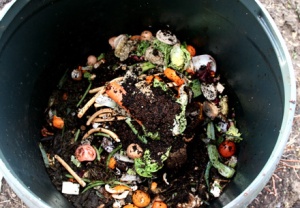All kinds of plants, including vegetables, need enriched soil to grow well and our native soil unfortunately does not have many of the nutrients that are important for plants. The most eco-friendly way to give your plants the nutrients they need is by composting.
 Composting is a natural process where organic material like kitchen scraps, dead leaves and twigs break down into nutrients that are good for the soil and are easily taken up by the roots of plants. Not only does it save you money, and help your plants grow beautifully, it also reduces the amount of garbage you send to the county landfill.
Composting is a natural process where organic material like kitchen scraps, dead leaves and twigs break down into nutrients that are good for the soil and are easily taken up by the roots of plants. Not only does it save you money, and help your plants grow beautifully, it also reduces the amount of garbage you send to the county landfill.
There are several ways to compost. You can use a designated compost heap where you pile the kitchen and lawn waste in an open area, you can build a compost area or you can buy a portable composter. As part of the natural decomposition process, the compost will go through a phase where it does not smell very good, so your composting area should be located somewhere towards the back of the house or yard. Enclosed composters help with this issue by containing the smell. You should also make sure that it will get direct sunlight at least part of the day.
In order for the waste to break down, it needs three things: moisture, sunlight and air. Every week or two, you need to make sure that your compost is damp and aerated. If it has dried out, just add water and toss it to distribute the water around the pile. Tossing it loosens the pile up so that the compost microbes that break down the organic material can do their job. You can turn it with a pitchfork or rake, or if you have an enclosed composter, you can just turn the entire container.
You can use coffee grinds, egg shells, vegetable and fruit peels, greens, husks and seeds, uneaten cooked vegetables, old or rotten fruit or vegetables, old newspapers, dead (brown or yellow) or green fallen leaves or clippings.
Make sure not to put weeds in the composter, as that will spread their seeds to your plant beds, and also avoid using pet manure is you are using your compost for vegetables, since this can put you at risk for disease. Also avoid meat, fish and dairy kitchen waste, since this will attract pests like raccoons and mice.
As a rule, you should have a balance of “greens” and “browns” in your compost pile. Greens include green leaves, grass clippings, kitchen waste or manure, while browns include dead leaves, twigs, straw, shredded newspaper or wood chips.
Need help setting up a composter? Contact Jaguar Garden Designs and we will get you on your way to turning trash into rich soil.